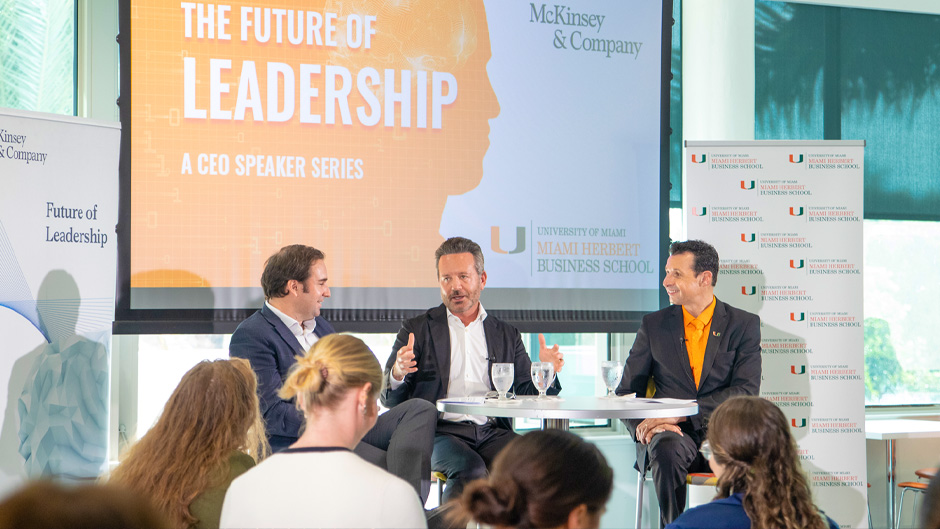With more than 25 years of experience as an executive and compliance consultant, Brent Saunders has witnessed—and helped to spur—the spiraling development of the pharmaceutical industry responsible for the global research, development, production, and distribution of medications.
The CEO and chair of the board of Bausch + Lomb, a pharmaceutical titan and one of the oldest existing companies in the country, shared his vision for the future of the eye care industry, emphasizing the import of research and development spurred by innovation, in a talk Wednesday with a University of Miami Patti and Allan Herbert Business School audience moderated by Dean Paul Pavlou and Pepe Campello, a partner at McKinsey & Company, which hosted the “Future of Leadership” session.
Saunders noted that his vision for the firm to be the best—“not the biggest because that’s dangerous”—eye care company in the world focused on two dimensions.
“First, making sure the customer has a reliable, high-quality supply of great products and servicing them becomes critically important,” said Saunders, who rejoined the company as its top executive in March 2023. “The second dimension is innovation, which is particularly important when you work in health care because the speed of innovation defines and impacts customers. Our ability to solve for disease of blindness or vision acuity and the ability to see—which is precious—depends on innovation.”
Pavlou asked how to best manage innovation.
“Listen to reports from the top KOLs (key opinion leaders) and academics in the field. Maybe have an advisory board develop one product or one R&D program around a product,” Saunders responded. “So get a lot of really smart people in a room and look for commonality in way of thinking or brilliant ideas from brilliant people, and then trust your instincts.
Saunders, who served as CEO of Bausch + Lomb from 2010-2013, highlighted the history and evolution of the firm, which launched during the Civil War when Henry Lomb sent his paycheck as a soldier in the Union army home to finance the startup of an optical shop. The firm went on to develop cameras that were used to film an Academy Award-winning film, took the first pictures of the moon, and in the 1970s created soft contact lenses. The company divested in the 1980s into its current four businesses, with 13,000 employees in 100 countries.
Saunders entered the health care industry by “accident.” While studying for his law degree, he got a job at a hospital to help pay his tuition. He helped oversee the hospital’s management care, a process just beginning at the time. Then, with law degree in hand, he was hired to oversee compliance. He went from working with 50 companies with smaller contracts to managing three with million-dollar contracts.
“It was really a move to have more sophisticated clients,” said Saunders, who shared that over his career he has managed health care industry acquisitions and mergers totaling $280 billion.
Saunders said his leadership style includes two foundational factors.
“If something can be done in two minutes, then do it right away. A lot of time people build up small tasks, but for me, even if it’s a 30-second phone call, you can get it off your plate,” he said. “And I’m a big believer in doing what you say you’ll do. There were many times in my career that I made commitments [that I realized I couldn’t keep], but I would always communicate that to the person. The lack of deliverables diminishes your career and credibility.”
Asked about his robust social media presence, Saunders explained that his oldest daughter suggested to him that he create an Instagram page when the platform was just launching.
He entered the platform principally to engage with his employees, sharing pictures of himself when visiting Shanghai or Berlin so they would know where he was and to inspire. His following grew to one million, and he began to use video clips.
“The biggest job of the CEO is to be the chief communicator,” Saunders said. “You have your stump speech and try to get your people excited around whatever the mission of the company is—you spend a lot of time talking about the company to employees. I avoid the political stuff; I don’t think that’s the space to do it.”
During the pandemic, he shifted his engagement from the social platform to more direct interoffice communication.
He emphasized the importance of regular eye exams and warned of an epidemic of myopia that’s affecting children today.
“Most people believe that if they can see, their eyes are working. Yet it’s so important to catch problems early when they’re largely preventable because it’s almost impossible to reverse damage that’s done,” he said. “While most eye disease has to do with aging, the eyes have muscles, and with children staring at a screen for so long, they’re not developing the muscles to see far, and we’re seeing an epidemic.”
Saunders ended his talk applauding the benefits that AI may well bring to the industry, pointing to improvements in workflow efficiency, preventive maintenance, data gathering, sales, and finance applications.
“In particular, in our field of drug discovery, it will be the biggest catalyst for change that I’ve seen in my career,” Saunders said. “We’re working with a company screening large amounts of data with samples, and things that we’re doing now in a day previously were taking a year. It’s massive.”

